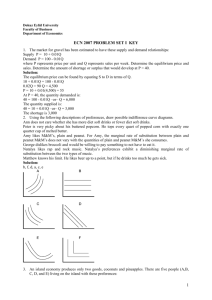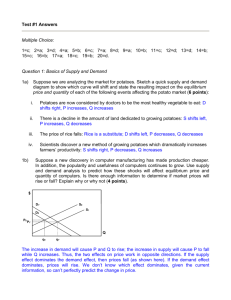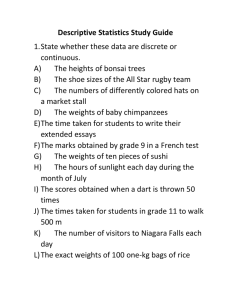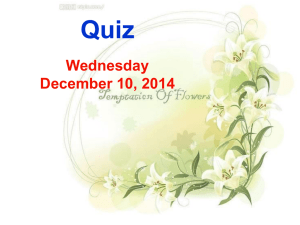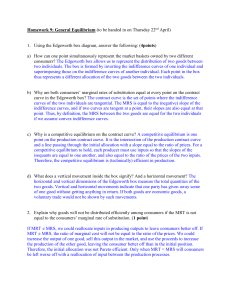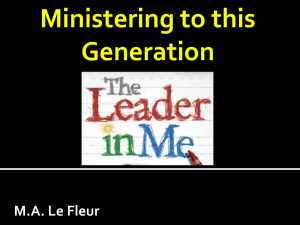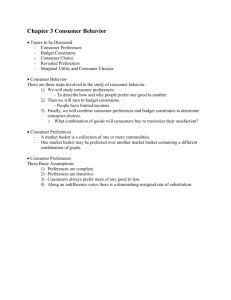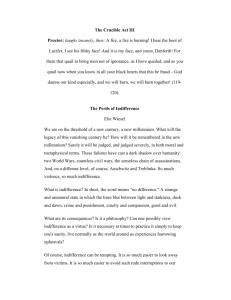Ch 3a
advertisement
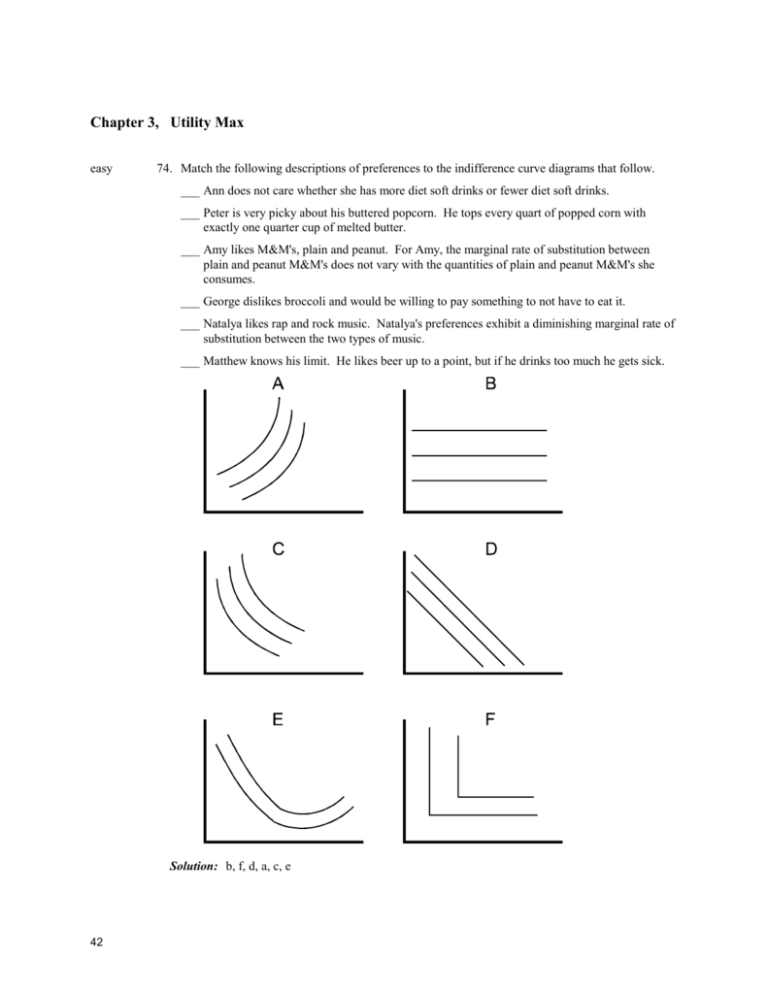
Chapter 3, Utility Max easy 74. Match the following descriptions of preferences to the indifference curve diagrams that follow. ___ Ann does not care whether she has more diet soft drinks or fewer diet soft drinks. ___ Peter is very picky about his buttered popcorn. He tops every quart of popped corn with exactly one quarter cup of melted butter. ___ Amy likes M&M's, plain and peanut. For Amy, the marginal rate of substitution between plain and peanut M&M's does not vary with the quantities of plain and peanut M&M's she consumes. ___ George dislikes broccoli and would be willing to pay something to not have to eat it. ___ Natalya likes rap and rock music. Natalya's preferences exhibit a diminishing marginal rate of substitution between the two types of music. ___ Matthew knows his limit. He likes beer up to a point, but if he drinks too much he gets sick. Solution: b, f, d, a, c, e 42 easy 76. An island economy produces only two goods, coconuts and pineapples. There are five people (A,B, C, D, and E) living on the island with these preferences: A has a strong preference for pineapples. B has a strong preference for coconuts. C doesn't care for pineapples (assigns no value to them). D doesn't care for coconuts (assigns no value to them) E will only consume pineapples and coconuts in the fixed proportion of one pineapple to one coconut. For each of these five individuals, construct a representative indifference curve with pineapples on the vertical axis and coconuts on the horizontal axis. Discuss the shape of the indifference curves and relate them to the MRS. Solution: 43 Individual A has relatively flat indifference curves, since A requires relatively large numbers of coconuts to compensate for the loss of pineapples that she values highly. Individual B has relatively steep indifference curves, since B requires relatively few coconuts to compensate for the loss of pineapples that he does not value highly. C's indifference curves are vertical; the level of satisfaction is affected only by coconuts. D's indifference curves are horizontal; the level of satisfaction is affected only by pineapples. E's indifference curves are L-shaped. MRS measures (at the margin) the maximum number of pineapples that the consumer will be willing to give up in order to get one more unit of coconuts. A's MRS is low. A is willing to relinquish few pineapples relative to coconuts since pineapples are dear to A. B's MRS is high, for the opposite reason. C's MRS is infinite. Since C's utility is not affected by pineapples, she is willing to relinquish all pineapples (an infinite number) to obtain additional coconuts. D's MRS is zero. D is not willing to give up any pineapples to obtain additional coconuts. E's MRS is infinite when Qp> Qc, zero when Qc > Qp, and undefined when Qc = Qp. moderate 77. The following combinations of goods X and Y represent various market baskets. Consumption is measured in pounds per month. Market Basket Units of X Units of Y A 4 6 B 16 7 C 15 3 D 3 2 Explain which market basket(s) is(are) preferred to other(s), and if there is any uncertainty over which is preferable, point this out as well. Solution: Since more of each good is preferred to less, we can conclude that a market basket is preferred to an alternative basket if it lies above and to the right of the alternative basket. Combination B is preferred to all others. A and C cannot be compared without additional information. A and C are both preferred over D. moderate 78. Consider Gary’s utility function: U(X,Y) = 5 XY, where X and Y are two goods. If the individual consumed 10 units of X and received 250 units of utility, how many units of Y must the individual consume? Would a market basket of X=15 and Y=3 be preferred to the above combination? Explain. Solution: Given that U(X,Y) = 5XY = 5(10)Y, then 250 = 50Y, or Y = 5. Since this individual receives 250 units of satisfaction with (X = 10, Y = 5), would (Y = 3 and X = 15) be a preferred combination? At these values, U = 5(15)(3) = 225. So, the first combination would be preferred. 44 moderate 83. The local farmer's market sells corn for 20 cents an ear. At this price, Sam buys 6 ears each Thursday. What would happen to Sam's consumption of corn if the market offered corn at 20 cents an ear for the first 6 ears, but 10 cents an ear for each additional ear? Explain your answer. Solution: Sam would buy more corn. 45 moderate 85. Hulk goes to the gym 20 times a month. His income is $1,000 per month and his visits to the gym cost $4 per visit. a. b. c. Solution: a. b. 46 Draw Hulk's budget line for visits to the gym and all other goods, show the consumption bundle that maximizes his satisfaction, and draw the indifference curve through that point. Recently, a new health club opened which offers identical facilities but which charges a flat fee of $60 per month plus an additional $1 per visit. Draw Hulk's budget line if he were to join this new club. Would Hulk continue to work out at the gym or would he join the new health club. Why? c. He would join the new health club. Although his current consumption bundle is on both budget lines, the health club’s pricing structure makes other, more preferred, bundles affordable. moderate 86. A consumer decides not to buy a VCR when her income is $20,000. However, when her income rises to $30,000, she decides to buy one. In a single diagram, draw the budget lines and indifference curves to illustrate this situation (assume the VCR costs $300 in both time periods). Be sure to label your diagram completely. Solution: At the lower budget constraint, the consumer is at a corner solution. That is, she purchases no VCRs. The consumer has sufficient income to afford a VCR. However, given her preferences it is optimal to exhaust her budget on other goods. With her increase in income, the budget constraint shifts out. The consumer now has expanded consumption opportunities. In this case, the consumer chooses to purchase a VCR given the higher budget constraint. Purchasing one VCR is optimal as the indifference curve is just tangent to the budget constraint at the consumption bundle consisting of 1 VCR. 47 difficult 90. Lisa's budget line and her satisfaction maximizing market basket, A, are shown in the diagram below. a. b. c. Suppose that Lisa is given $50 worth of coupons that must be spent on food. How will the coupons alter Lisa's budget line? Suppose that Lisa is given $50 in cash instead of $50 in coupons. How will this alter Lisa's budget line? Is Lisa indifferent between the food coupon and cash program, or does she prefer one program over the other? Draw an indifference curve to illustrate your answer. Solution: Refer to the following diagram with the answers. 48 a. With the coupons, Lisa’s budget is abc. b. With cash, Lisa’s budget line is dbc. c. If Lisa’s preferences are as shown, she is indifferent between the two programs. However, if her preferences were such that an indifference curve was tangent to the db portion of dbc, she would prefer cash. 49
